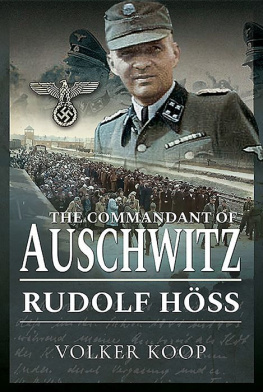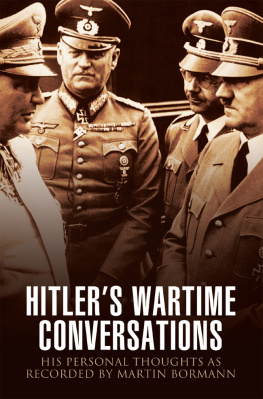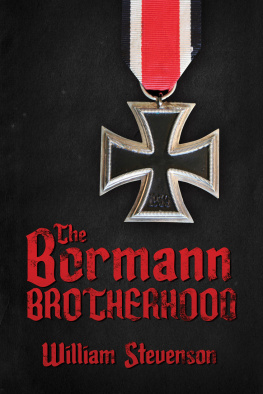Pagebreaks of the print version

Martin Bormann
Martin Bormann
Volker Koop
Published in 2020 by Frontline Books,
an imprint of Pen & Sword Books Ltd,
47 Church Street, Barnsley, S. Yorkshire, S70 2AS
www.frontline-books.com
Copyright Volker Koop 2020
The right of Volker Koop to be identified as the author of this work has been asserted by him in accordance with the
Copyright, Designs and Patents Act 1988.
ISBN: 9781473886926
ISBN: 9781473886940
ISBN: 9781473886933
All rights reserved. No part of this publication may be reproduced, stored in or introduced into a retrieval system, or transmitted, in any form, or by any means (electronic, mechanical, photocopying, recording or otherwise) without the prior written permission of the publisher. Any person who does any unauthorized act in relation to this publication may be liable to criminal prosecution and civil claims for damages.
CIP data records for this title are available from the British Library
For more information on our books, please visit
or write to us at the above address.
Typeset by Lapiz Digital Services
Pen & Sword Books Ltd incorporates the imprints of Pen & Sword
Archaeology, Atlas, Aviation, Battleground, Discovery,
Family History, History, Maritime, Military, Naval, Politics,
Social History, Transport, True Crime, Claymore Press,
Frontline Books, Praetorian Press,
Seaforth Publishing and White Owl
For a complete list of Pen and Sword titles please contact
PEN & SWORD LTD
47 Church Street, Barnsley, South Yorkshire, S70 2AS, England
E-mail:
Or
PEN AND SWORD BOOKS
1950 Lawrence Rd, Havertown, PA 19083, USA
E-mail:
Preface
Martin Bormann was without a doubt one of the most important supporters of the National Socialist regime. It is striking that his personal power as number two to Hitler increased at the same rate as the Third Reich was coming to an end.
Bormann did not belong to Hitlers comrades-in-arms, and also joined the National Socialist German Workers Party (NSDAP or Nazi Party) only at a relatively late date, but he knew how to raise his profile within it, for example with the aid of the Adolf Hitler Fund of German Trade and Industry initiated by him in 1933. From the voluntary contributions by German industrialists originated a significant fund from which he allocated money to top-ranking party functionaries.
As manager of the Obersalzberg in the Berchtesgadener Land district in the Bavarian Alps since 1923 Hitlers holiday residence that after 1933 was developed into a second seat of government besides Berlin Bormann was constantly in Hitlers immediate vicinity and made himself indispensable. Under his direction and based on Hitlers designs, the formerly simple Berghof was turned into a modern residence. Other Nazi greats had houses here, but it is characteristic that Bormann could literally look down upon all the others from this house.
When Bormann became chief of staff of Deputy Fhrer Rudolf He, it was by no means foreseeable that one day he would become the most powerful figure in the Nazi regime after Hitler. He became increasingly in charge of He office, but only He flight to Scotland on 10 May 1941, undertaken in the naive belief that he would be able to induce the British to withdraw from the war, brought a decisive turn in Bormanns life: he rose past all rivals and adversaries to the highest party hierarchy. On the evening after He flight, Bormann allegedly threw a party at the Obersalzberg, as if he personally had to celebrate the event.
To paint an accurate picture of Bormann is not easy. He did not write diaries, did not make speeches as did, for example, Minister for Propaganda Joseph Goebbels. His actual legacy is composed of the countless instructions, statements and circular letters he produced day by day. In the documents of his political opponents and there were many of them we find rather more with respect to Bormanns personal profile than in the records of the NSDAP Party Chancellery. The left behind documents in the offices of Alfred Rosenberg, Robert Ley, Hans Heinrich Lammers and Heinrich Himmler, and comparable Nazi politicians were therefore an important foundation for the writing of this book.
Another source to decode Bormanns personality is his correspondence with his wife Gerda, which causes previously accepted views on the Fhrers secretary to waver, at least in parts. If in Bormanns orders and in the documents of his Nazi contemporaries the ruthless power-seeker is revealed, we encounter in the letters the loving, apparently still besotted husband and father who does not seem to fit into the image of the otherwise so callous head of the Chancellery. In the preface to the publication of these letters in 1954, Franois Genoud, into whose possession the letters had come, shocked with his confession that during his reading he had felt a certain sympathy for Bormann. This statement by Genoud should not surprise us, however, since he was an ardent supporter of National Socialism and by agreeing contracts with families and testamentary executors had obtained the exploitation rights for texts by Hitler, Goebbels and Bormann. While the authenticity of Bormanns minutes regarding his conversations with Hitler is doubted by some historians, this is not the case with Bormanns correspondence. If therefore the correspondence between Martin and Gerda is genuine, as it is to be assumed, then it can be concluded from this that Bormann was ultimately a lonely man. This emerges from almost every example of his many letters, unfortunately only published in English translation.
It may be that for him exercising power was a compensation for the extensive sacrifice of his private life. Bormann wanted power and used it to work off personal antipathies and to conduct his war against the churches, for example. The price for his thirst for power was paid by the German people and those in the countries it occupied and ruled in this sense pity or even sympathy with Bormann would be wholly misplaced. He was Hitlers alter ego and executor. He was not only involved in the inhuman politics of the National Socialists, but was also their driving force. He was a mysterious personality in life and especially after his death. The aim of the book is to shed some light onto this grim chapter of German history linked inextricably with the name of Bormann.
Hitlers Executor
Beginnings in the NSDAP
Martin Bormann was born on 17 June 1900 in Halberstadt into a decidedly lower middle-class family, which probably had an essential influence on his later life. As ambitious as he was, he compensated his origins with a highly remarkable party career within the NSDAP. His father Theodor was a senior post assistant and former army musician. After the death of his first wife Luise, with whom he had two children Else and Walter in 1898 Theodor married Antonie Bernhardine Mennong. The couple became parents of three sons, of whom only Martin and Albert survived, who both would later enter into Hitlers service. Theodor died in 1903 and Martin and Albert were thus half-orphans from a very early age. Antonie then married the bank clerk Albert Vollborn.
In view of the racial and ancestral mania prevalent during the Third Reich it was important to Bormann just as to any leading representative of the regime to adorn himself with an ancestral gallery reaching far back in time. Investigators from Himmlers SS Racial Office thus received the commission to establish the truth behind his ancestry and were still occupied with this task when the end of the Third Reich was nigh. Secretary of State Gerhard Klopfer, who had processed racial issues at Bormanns Party Chancellery for years, wrote on 27 June 1944 to the head of Himmlers personal staff, SS Standartenfhrer Rudolf Brandt:













